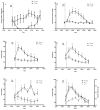Protein Ingestion in Reducing the Risk of Late-Onset Post-Exercise Hypoglycemia: A Pilot Study in Adolescents and Youth with Type 1 Diabetes
- PMID: 36771250
- PMCID: PMC9920079
- DOI: 10.3390/nu15030543
Protein Ingestion in Reducing the Risk of Late-Onset Post-Exercise Hypoglycemia: A Pilot Study in Adolescents and Youth with Type 1 Diabetes
Abstract
Dietary protein causes dose-dependent hyperglycemia in individuals with type 1 diabetes (T1D). This study investigated the effect of consuming 50 g of protein on overnight blood glucose levels (BGLs) following late-afternoon moderate-intensity exercise. Six participants (3M:3F) with T1D, HbA1c 7.5 ± 0.8% (58.0 ± 8.7 mmol/mol) and aged 20.2 ± 3.1 years exercised for 45 min at 1600 h and consumed a protein drink or water alone at 2000 h, on two separate days. A basal insulin euglycemic clamp was employed to measure the mean glucose infusion rates (m-GIR) required to maintain euglycemia on both nights. The m-GIR on the protein and water nights during the hypoglycemia risk period and overnight were 0.27 ± 043 vs. 1.60 ± 0.66 mg/kg/min (p = 0.028, r = 0.63) and 0.51 ± 0.16 vs. 1.34 ± 0.71 mg/kg/min (p = 0.028, r = 0.63), respectively. Despite ceasing intravenous glucose infusion on the protein night, the BGLs peaked at 9.6 ± 1.6 mmol/L, with a hypoglycemia risk period mean of 7.8 ± 1.5 mmol/L compared to 5.9 ± 0.4 mmol/L (p = 0.028) on the water night. The mean plasma glucagon levels were 51.5 ± 14.1 and 27.2 ± 10.1 ng/L (p = 0.028) on the protein and water night, respectively. This suggests that an intake of protein is effective at reducing the post-exercise hypoglycemia risk, potentially via a glucagon-mediated stimulation of glucose production. However, 50 g of protein may be excessive for maintaining euglycemia.
Keywords: LOPEH; glucagon; hypoglycemia; moderate intensity exercise; protein; type 1 diabetes.
Conflict of interest statement
The authors declare no conflict of interest. The funders had no role in the design of the study; in the collection, analyses, or interpretation of data; in the writing of the manuscript, or in the decision to publish the results.
Figures

References
-
- McMahon S., Ferreira L.D., Ratnam N., Davey R., Youngs L.M., Davis E.A., Fournier P.A., Jones T.W. Glucose Requirements to Maintain Euglycemia after Moderate-Intensity Afternoon Exercise in Adolescents with Type 1 Diabetes Are Increased in a Biphasic Manner. J. Clin. Endocrinol. Metab. 2007;92:963–968. doi: 10.1210/jc.2006-2263. - DOI - PubMed
MeSH terms
Substances
Grants and funding
LinkOut - more resources
Full Text Sources
Medical
Research Materials
Miscellaneous

